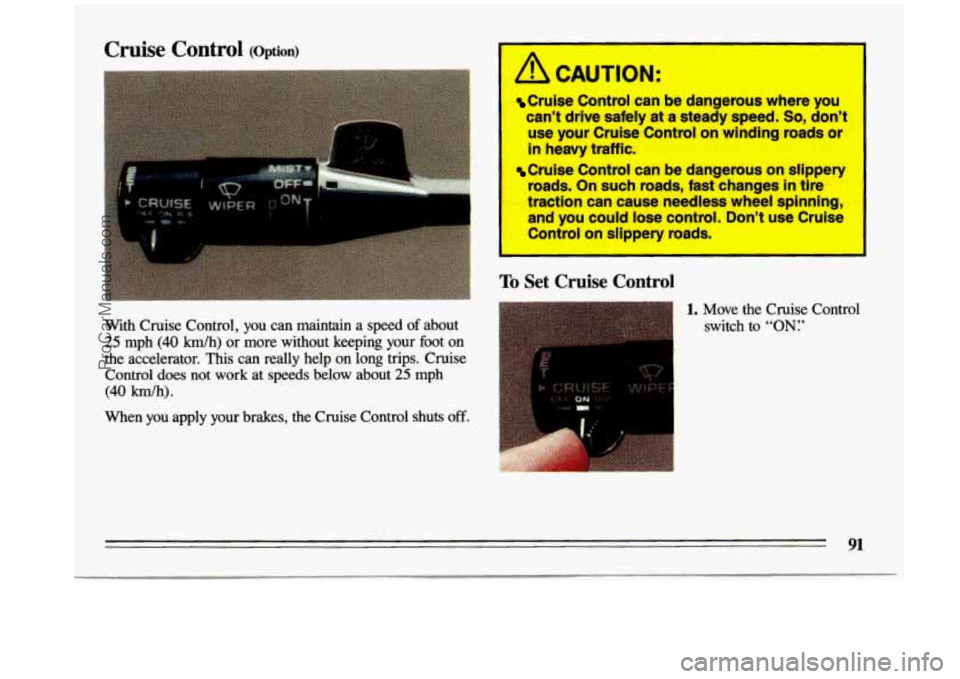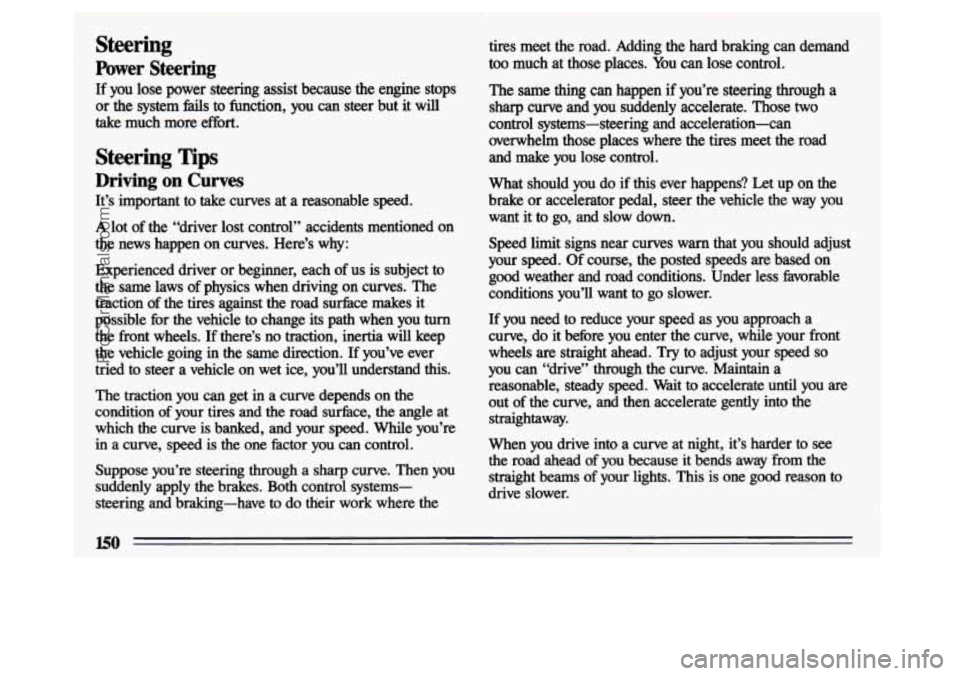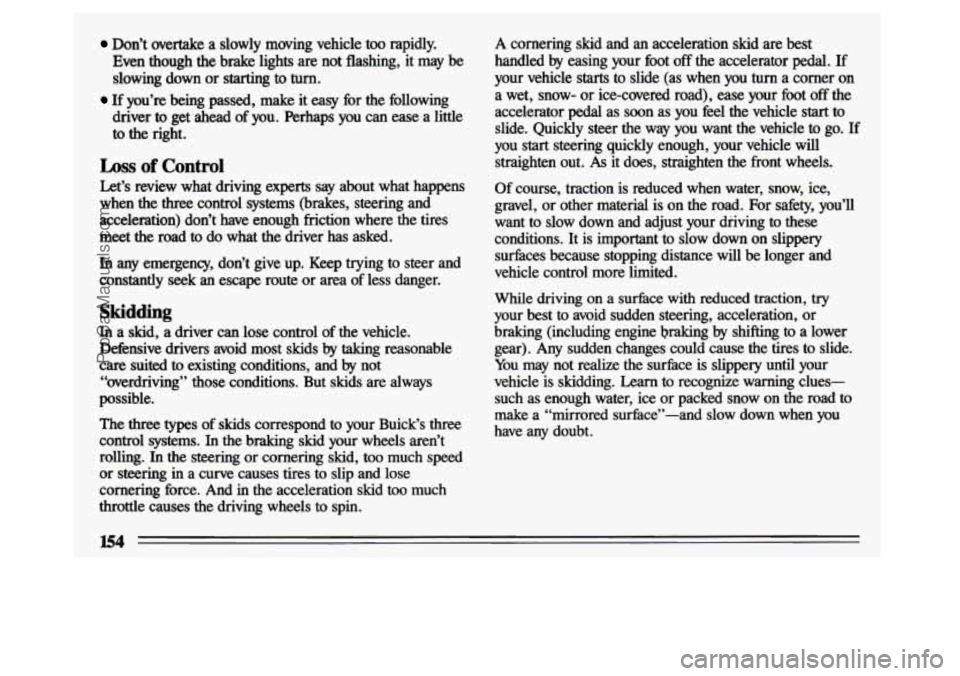1993 BUICK CENTURY traction control
[x] Cancel search: traction controlPage 93 of 324

Cruise Control (option)
. .
- ~ "IWC.
. .. -
With Cruise Control, you can maintain a speed of about
25 mph (40 Wh) or more without keeping your foot on
the accelerator.
This can really help on long trips. Cruise
Control does not
work at speeds below about 25 mph
(40 Wh).
When you apply your brakes, the Cruise Control shuts
off.
A CAUTION:
Cruise Control can be dangerous where you
can't drive safely
at a steady speed. So, don't
use your Cruise Control on winding roads or
in heavy traffic.
Cruise Control can be dangerous on slippery
roads.
On such roads, fast changes in tire
traction can cause needless wheel spinning,
and you could lose control. Don't use Cruise
Control on slippery roads.
To Set Cruise Control
1. Move the Cruise Control
switch
to "ON?
91
ProCarManuals.com
Page 152 of 324

Steering
Power Steering
If you lose power steering assist because the engine stops
or the system
fails to function, you can steer but it will
take much more effort.
Steering Tips
Driving on Curves
It’s important to take curves at a reasonable speed.
A lot of the “driver lost control” accidents mentioned on
the news happen on curves. Here’s why:
Experienced driver or beginner, each of us is subject to
the same laws of physics when driving on curves. The
traction
of the tires against the road surface makes it
possible for the vehicle to change its path when you turn
the front wheels. If there’s no traction, inertia will keep
the vehicle going
in the same direction. If you’ve ever
tried to steer a vehicle on wet ice, you’ll understand
this.
The traction you can get in a curve depends on the
condition
of your tires and the road surhce, the angle at
which the curve is banked, and your
speed. While you’re
in a curve, speed is the one factor you can control.
Suppose you’re steering through
a sharp curve. Then you
suddenly apply
the brakes. Both control systems-
steering and braking-have
to do their work where the
tires meet the road. Adding the hard braking can demand
too much at those places. You can lose control.
The
same thing can happen if you’re steering through a’
sharp curve and you suddenly accelerate. Those two
control systems-steering and acceleration-can
overwhelm those places where the tires meet the road and make you lose ‘control.
What should you do
if this ever happens? Let up on the
brake or accelerator
pedal, steer the vehicle the way you
want it to go, and slow down.
Speed limit signs near curves warn that you should adjust
your
speed. Of course, the posted speeds are based on
good weather and road conditions. Under less favorable
conditions you’ll want
to go slower.
If you need to reduce your speed as you approach a
curve, do it before you enter the curve, while your front
wheels
are straight ahead. Try to adjust your speed so
you can “drive” through the curve. Maintain a
reasonable, steady speed. Wait to accelerate until you are
out of the curve, and then accelerate gently into the
straightaway.
When you drive
into a curve at night, it’s harder to see
the road ahead of you because it bends away .from the
straight beams of your lights.
This is one good reason to
drive slower.
ProCarManuals.com
Page 156 of 324

Don’t overtake a slowly moving vehicle too rapidly.
Even though the brake lights are not flashing, it
may be
slowing down or starting to turn.
driver to get ahead of you. Perhaps you can ease a little
to the right.
If you’re being passed, make it easy for the following
Loss of Control
Let’s review what driving experts say about what happens
when the three control systems (brakes, steering and
acceleration) don’t have enough friction where the tires
meet the road
to do what the driver has asked.
In any emergency, don’t give up. Keep trying to steer and
constantly
seek an escape route or area of less danger.
Skidding
In a skid, a driver can lose control of the vehicle.
Defensive drivers avoid most skids
by taking reasonable
care suited
to existing conditions, and by not
“overdriving” those conditions. But skids are always
possible.
The three types
of skids correspond to your Buick‘s three
control systems. In the braking skid your wheels aren’t
rolling.
In the steering or cornering skid, too much speed
or steering in a curve causes tires to slip and lose
cornering force. And
in the acceleration skid too much
throttle causes the driving wheels to spin.
I
A cornering skid and an acceleration skid are best
handled by easing your foot
off the accelerator pedal. If
your vehicle starts to slide (as when you turn a corner on
a wet, snow- or ice-covered road), ease your
foot off the
accelerator pedal as soon as you feel the vehicle start to
slide. Quickly steer the way you want the vehicle to go. If
you
start steering quickly enough, your vehicle will
straighten out. As it does, straighten the front wheels.
Of course, traction is reduced when water, snow, ice,
gravel, or other material is on the road.
For safety, you’ll
want to slow down and adjust your driving
to these
conditions. It is important to slow down on slippery
surfaces because stopping distance will be longer and
vehicle control more limited.
While driving on a surfhce
with reduced traction, try
your best to avoid sudden steering, acceleration, or
braking (including engine braking
by shifting to a lower
gear).
Any sudden changes could cause the tires to slide.
You may not realize the surface is slippery until your
vehicle is skidding.
Learn to recognize warning clues-
such as enough water, ice or packed snow on the road
to
make a “mirrored surface”-and slow down when you
have
any doubt.
154
ProCarManuals.com
Page 257 of 324

*
I A CAUTION:
Mlxing tires could cause you to lose control
while driving.
If you mlx tires of different sizes
or types (radial and bias-belted tires) the
vehlcle may not handle
properly, and you
could have
a crash. Be sure to use the same
size and type
tires on all four wheels. It’s all
right to drive wlth your compact spare,
though.
It was developed far use on your
vehicle.
I
Uniform Tire Quality Grading
The following information relates to the system developed
by the United States National Highway Traffic Safety
Administration which grades tires by treadwear, traction
and temperature performance. (This applies only to
vehicles
sold in the United States.)
Treadwear
The treadwear grade is a comparative rating based on the
wear rate of the tire when
tested under controlled
conditions on a specified government test course. For
example, a tire graded
150 would wear one and a half
(1%) times as well on the government course
as a tire
graded
100. The relative performance of tires depends
upon the actual conditions of their use, however, and may
depart significantly from the norm due to variations
in
driving habits, service practices and differences in road
characteristics and climate.
Traction-A, B, C
The traction grades, from highest to lowest are: A, B,
and C. They represent the tire’s ability to stop on wet
pavement as measured under controlled conditions on specified government test surfaces of asphalt and
concrete.
A tire marked C may have poor traction
performance.
Warning: The traction grade assigned to this tire is based
on braking (straight-ahead) traction tests and does not
include cornering (turning) traction.
255
ProCarManuals.com